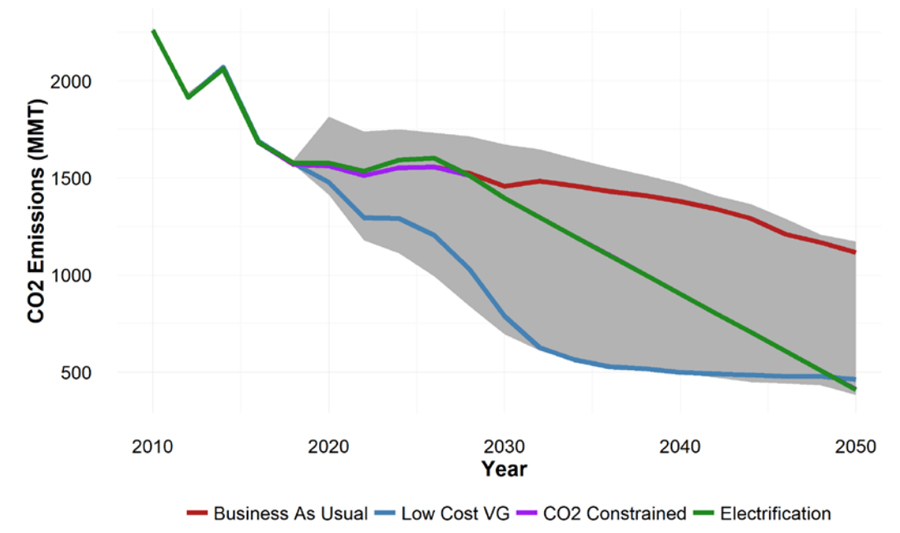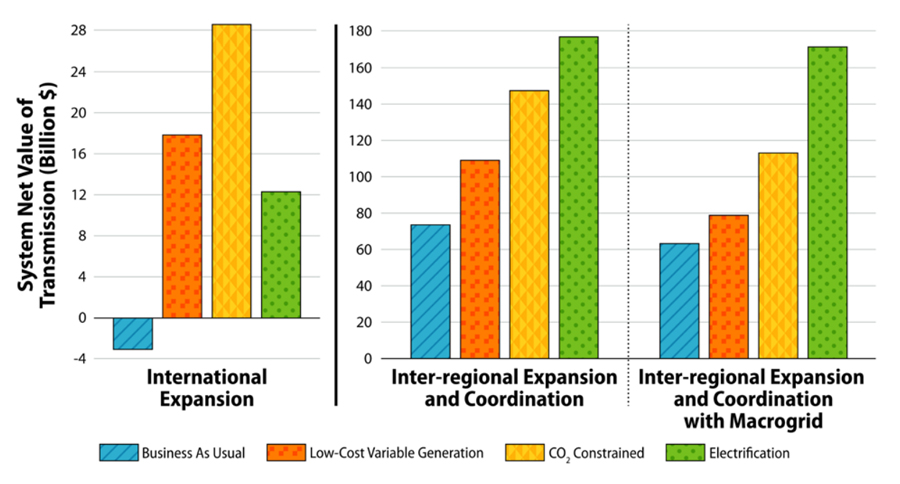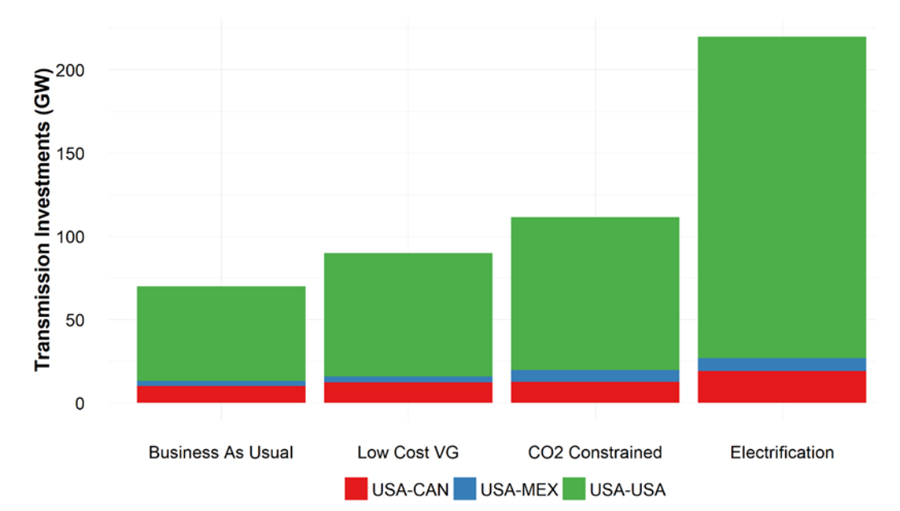A new study from the National Renewable Energy Laboratory says that the most effective way to cut at least 80% of greenhouse gas emissions from North America’s power systems by 2050 will be to put as much low-cost wind and solar on the grid as possible, electrify everything, and build hundreds of gigawatts of new transmission capacity.
The North American Renewable Integration Study (NARIS) also envisions a small but significant amount of those new transmission lines running across U.S. borders with both Canada and Mexico.
“Our big-picture, take-home messages are that we can maintain [resource] adequacy while going to these high [renewable] contribution scenarios,” said Gregory Brinkman, a senior engineer at NREL and principal investigator on the study. Another key takeaway: “Cooperation and transmission expansion are really, really valuable,” he said.
Brinkman said such findings are not particularly unexpected or shocking. Rather, the value of the report lies in its efforts to look at North America’s power systems holistically and its extensive modeling of the opportunities for system efficiencies and cost savings that may be available with different low-cost renewable, emission-reduction and electrification scenarios, and the transmission buildouts each will require.

For example, the study finds that ramping up low-cost wind and solar over the next decade could provide deeper cuts in carbon emissions in the near term than either targeting an 80% drop in carbon emissions or electrifying transportation.
The report also estimates net benefits of new cross-border transmission at $10 billion to $30 billion between 2020 and 2050, based on total capital and operational costs, Brinkman said. The corresponding benefits of building out interregional transmission in the U.S. could pencil out at $60 billion to $180 billion, the report says. Those benefits do not include “externalities” such as the social and health benefits of lower emissions, Brinkman said.
The report, which includes parallel U.S. and Canadian versions, was released alongside a memorandum of understanding on cross-border cooperation signed at a June 24 meeting between U.S. Energy Secretary Jennifer Granholm and Canadian Minister of Natural Resources Seamus O’Regan. The nonbinding MOU includes a long list of potential areas for “sharing knowledge and exploring options” and best practices, such as vehicle electrification, grid reliability and cybersecurity, and improving energy access and resilience for remote and Arctic communities.
While the MOU commits neither country to providing any funds for collaborative projects or to even regular meetings, it is founded on mutual interests and needs that will likely intensify in the coming decades.

“No two countries in the world have their energy sectors as closely linked as Canada and the United States do,” O’Regan said in a joint announcement of the MOU, emphasizing the economic benefits of cross-border energy exchanges between the two countries. According to the U.S. Energy Information Administration, Canada is the largest energy supplier to the U.S. and, after Mexico, the second largest market for U.S. energy exports.
In dollar terms, EIA pegged U.S. energy imports from Canada at more than $80 billion in 2019, about four times the exports from the U.S. to Canada.
Granholm framed the MOU as a bilateral commitment to “ensure that all pockets of North America have access to affordable, clean energy. We can’t tackle the climate crisis alone,” she said. “We must work together to accelerate the flow of low-carbon electricity across our borders.”

Exactly how much energy will be crossing borders and how much transmission will be needed to ensure reliability and resource adequacy are more difficult to gauge. One of the weaknesses of the report is that it measures new transmission in terms of megawatts of capacity, not miles. Putting low-cost solar and wind on the grid could require about 100 GW of new capacity on the transmission system versus 200 GW required for electrification of buildings and transportation.
New wires going between Mexico and the U.S. would only need 3 to 8 GW of capacity, and U.S.-Canada lines would need 10 to 20 GW, the report says. Mapping out new transmission needed to increase renewables, cut emissions and electrify buildings and transportation, the report shows an increasingly thick web of new lines connecting regions across the U.S. itself.
Slightly Outdated Data
The self-acknowledged limitations of the NARIS report are significant, as seen in the four basic scenarios it covers.
The business-as-usual pathway is based on state and federal legislation enacted as of October 2018, meaning many of state emissions-reduction targets enacted in the past three years are not part of the modeling. Similarly, the low-cost variable generation (VG) scenario uses 2018 prices to model the costs of its high penetrations of wind and solar, again not capturing the ongoing cost reductions.
It is also the only model to envision a growing role for distributed rooftop solar, 160 GW by 2050 versus 60 GW in all other options.
The report’s carbon-constrained scenario works not toward a 2050 target of net zero emissions, but an 80% target in the U.S and Mexico and 92% in Canada. As a result, gas-fired generation remains online even in the report’s most aggressive pathway for electrifying transportation and building energy consumption. NREL’s Brinkman said the gas generation there, and in the business-as-usual and low-cost VG models, would be primarily for backup power.
Another problem: The scenarios’ modeling of solar and wind output is based on weather data from 2007 to 2014, and the impacts of climate change, or the extreme weather events of recent years, are not included.
Brinkman said the decisions on weather inputs were based on the need for “high-quality data,” defending the report’s findings as “robust” and not likely to change with future research.
“Climate change is really tough to model in terms of its impact on potential demand patterns and also potential wind and solar patterns,” he said. “It’s really important that we get all three of those things consistent with each other, because they are highly correlated.”
But the impacts of climate change could also affect the role of hydropower in the different scenarios, especially in Canada, where hydro is one of the country’s primary sources of exportable renewable power. Drought in the Western U.S. has already cut hydropower resources there — the Hoover Dam is currently running at about 66% efficiency — and similar reductions could occur in Western Canada.
At the same time, one study shows increased precipitation and snow melt could boost hydropower output in the eastern part of the country. Such an increase could bode well for a new transmission line, the Champlain Hudson Power Express, being developed to bring up to 1,250 MW of hydro power from Quebec to New York. The Canadian government also recently issued a final permit to begin construction of its portion of the New England Clean Energy Connect transmission line, which would bring hydro from Canada across Maine and into Massachusetts.
Both international and interregional connections will be essential for resource adequacy going forward. By 2050, the report shows such transmission will be critical for most U.S. grid operators to meet power and capacity shortfalls. More than 150 TWh of power could be moving across the Canadian-U.S. border, in both directions, the report says. In the low-cost VG scenario, for example, 32% of energy exports are from the U.S. to Canada.



